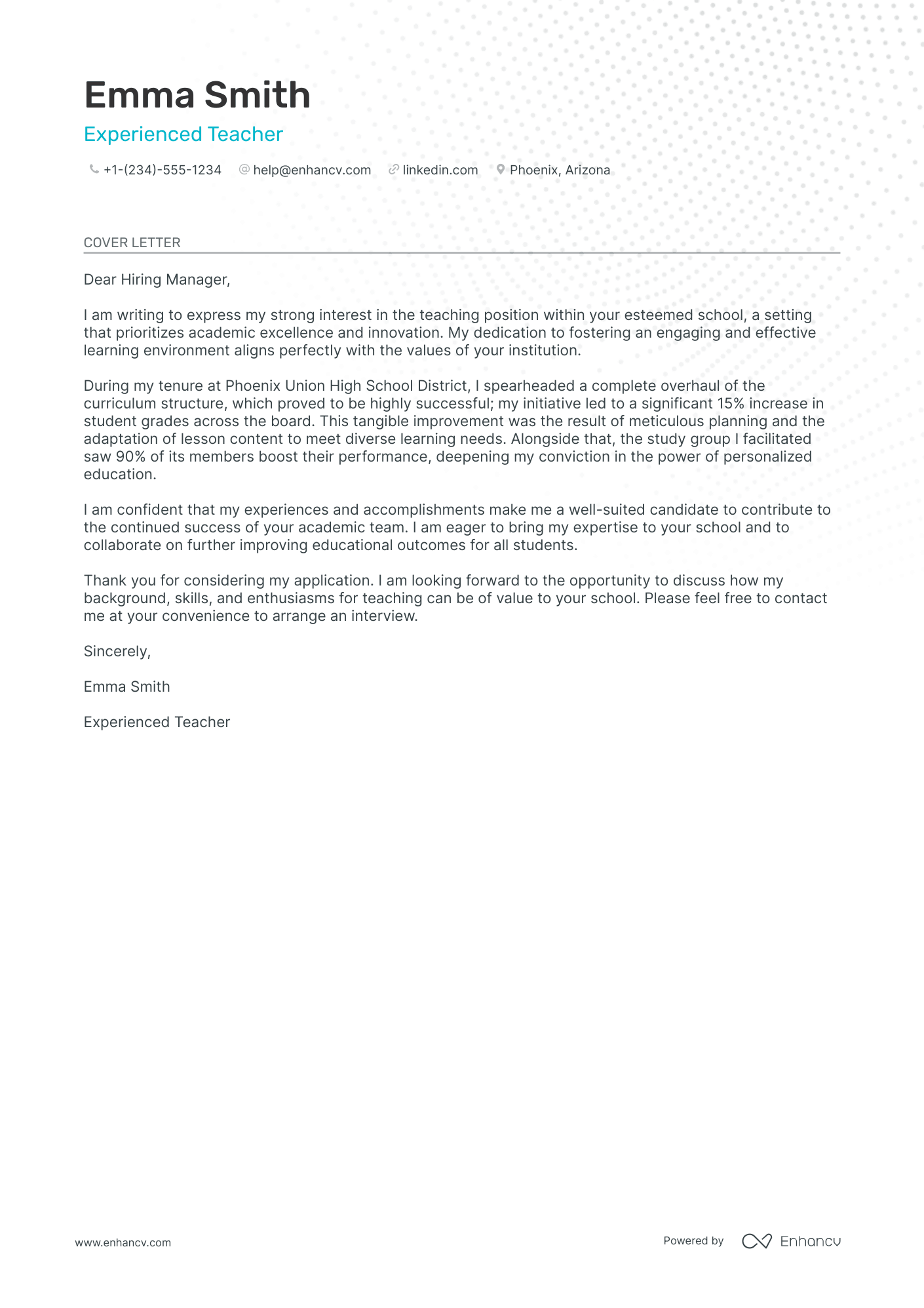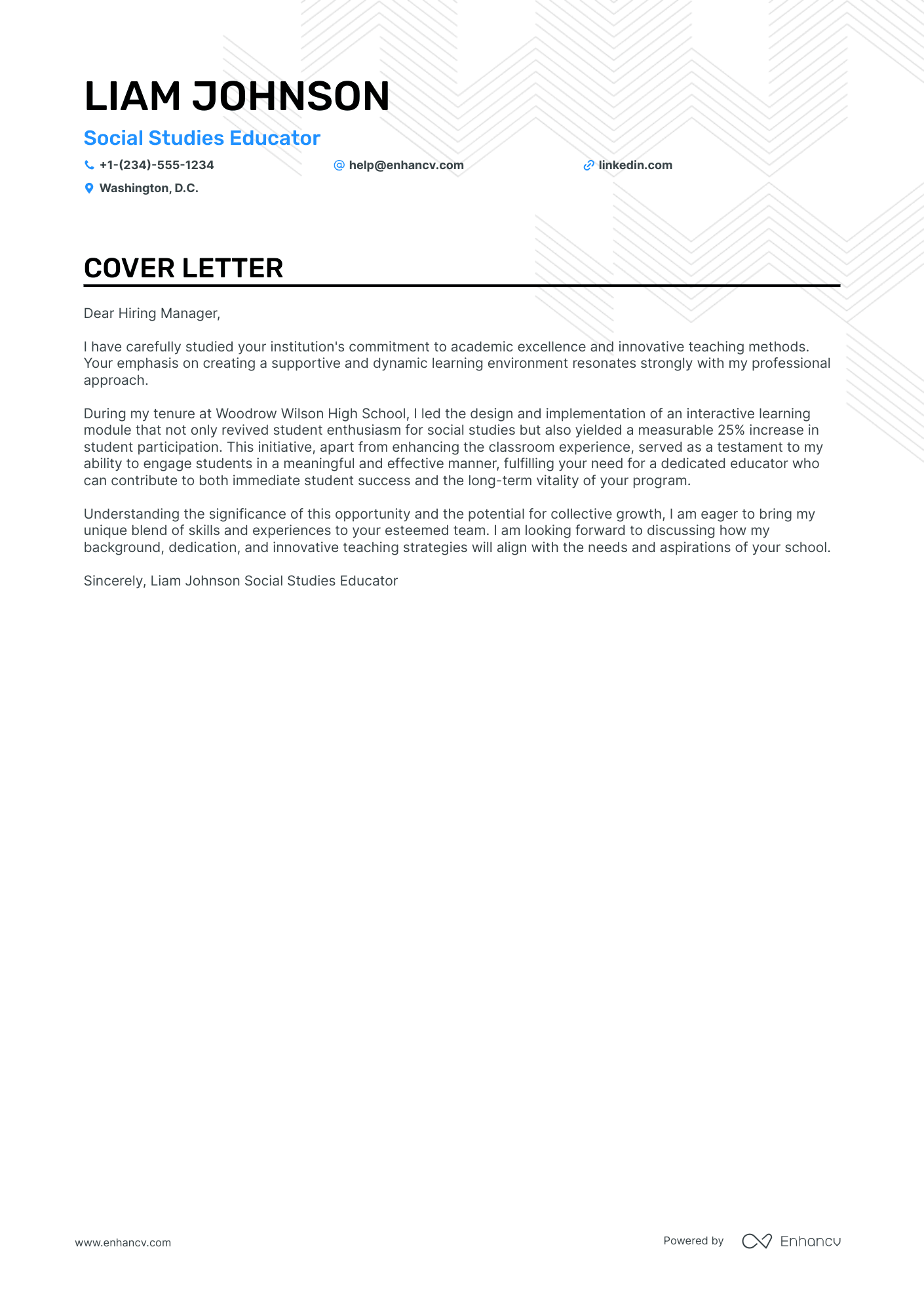The teacher shortage in the U.S. is real, with states like California and Florida attracting a flood of applicants, making it tougher for new teachers to stand out. Meanwhile, rural areas face severe shortages but come with their own challenges. Whether you're vying for a competitive spot or applying in an area with fewer candidates, a well-crafted cover letter is crucial to helping you land an interview.
A strong cover letter allows you to highlight your personality and passion for teaching—qualities that can sometimes be hard to capture in a resume alone. This is your opportunity to go beyond bullet points, demonstrating how your unique skills and fresh perspective can bring value to the classroom.
In this guide, we’ll help you create a compelling new teacher cover letter that can tip the scales in your favor. When paired with a well-crafted resume, it can show you're not only qualified but also excited and ready to make an impact as a new teacher.
Let’s dive in.
New teacher cover letter sample
If your resume for a new teacher is already meticulously crafted, check out our cover letter sample—it’s an excellent starting point to help you build your own.
ALANA P. TAYLOR
Bethel, AK
(907) 555-0132
alanataylor.ak@enhancv.com
Lower Kuskokwim School District
123 Riverbank Avenue
Bethel, AK 99559
If you’re ready to explore the specifics of crafting this essential piece of communication, the next sections are designed just for you.
How to format your new teacher cover letter
As a new teacher, you might worry that your cover letter doesn’t have enough experience to showcase or that it feels like a writing contest where you have to prove yourself through impressive language.
The good news is that a well-formatted, clearly structured letter can do a lot of the work for you. It’s not about how many accomplishments you can list, but how clearly and professionally you present yourself.
Ideally, a cover letter outline should include:
- A header with your contact information.
- A polite greeting that addresses the hiring manager directly (if possible).
- A body of text highlighting your top three accomplishments or skills.
- A final sentence that includes a call to action, such as arranging an interview, and a closer.
We’ll delve into each of these elements further down, but for now, let’s first consider the overall design of your letter.
Don’t let cover letters slow you down. Use our free cover letter generator to create one in no time.
PRO TIP
If you’re unsure how to approach this part of the process, consider using one of our cover letter templates. They provide everything you need for an elegant presentation that makes a great first impression.
Cover letter design tips
- Set your page margins to a maximum of one inch, align the text to the left, and ensure there’s double spacing between paragraphs.
- Use a standard font like Arial, Times New Roman, or Lato, sized between 10-12 points.
- Avoid being overly verbose—effective cover letters rarely exceed 400 words.
Contact information
- Fill the header with the correct details in the same style and order as your resume—your full name, job title, phone number, professional email, LinkedIn profile, and location.
- Consider inserting your company logo. While photos on resumes and cover letters are generally omitted, a logo can enhance your personal branding.
- Include the date and the recipient’s information. Just below these, add a reference to the job you’re applying for.
Cover letter file format
- Have your letter printed. It’s useful for proofreading or getting a second opinion. Plus, it serves as a professional backup to bring along to interviews in case it’s needed.
- Use standard US paper size for printed cover letters and resumes—8.5 x 11 inches.
- Submit your cover letter or resume as a PDF when applying online. PDFs ensure your formatting stays intact across different devices and systems, and they’ll pass through any applicant tracking systems (ATS) recruiters might be using.
PRO TIP
While cover letters are the first application document recruiters glance at, some may skip straight to the resume, especially if they’re pressed for time or using an ATS. However, to impress the first group—the ones who prioritize reading the letter first—be sure to tick all the boxes from our cover letter checklist.
Here are five key traits school administrators and hiring committees look for in a new teacher's cover letter:
Key qualities of a new teacher
- Genuine enthusiasm: Show passion for teaching and working with students. Administrators want to see you’re driven to make a difference, not just land a job.
- Relevant experience: Even as a new teacher, highlight student teaching, internships, or volunteer work. Focus on skills like classroom management and lesson planning.
- Fit with school culture: Demonstrate that your teaching style aligns with the school's values and mission.
- Adaptability to diverse students: Schools value flexibility. Underline any experience working with different learning needs or backgrounds.
- Professionalism: A clear, error-free cover letter signals attention to detail and organization—qualities crucial for any teacher.
Next, let’s explore how you can begin writing your cover letter.
How to choose the right cover letter salutation
The cover letter salutation is the opening where you formally address the hiring manager or the school. This small but crucial detail sets the tone for your entire letter, and getting it right can make a strong first impression.
Avoid common mistakes
Many candidates use a generic greeting like "To Whom It May Concern" or "Dear Sir/Madam." These feel impersonal and show a lack of effort in tailoring your application.
Instead, try to find the name of the principal, hiring manager, or head of the school district. If you can't find their name, a more specific greeting like "Dear Hiring Committee" or "Dear [School Name] Administration" can still feel professional and relevant.
How to write your first-year teacher cover letter intro
It’s quite common for educational institutions to require a cover letter to understand a candidate’s profile better. The cover letter often provides context that a resume alone can't. Use it to emphasize your enthusiasm for teaching in a specific environment, like working with underserved students or integrating innovative teaching methods.
The introduction, however, is your hook. It might be the only reason a hiring manager would even read your resume.
So, here’s how to tie your interest with the school or role from the very first lines:
- Mention the specific teaching role you're applying for and why you’re excited about this particular school or district.
- Briefly explain why you’re a good fit by mentioning a relevant qualification or experience.
- Wrap up with a hint at what’s to come in the body of the letter, where you’ll elaborate further.
We’ll use the highlighted phrases of a real-world new teacher job description to tailor our examples, starting with the cover letter intro.
Now, look at the tailored example of a new teacher's cover letter intro:
This introduction works effectively for several reasons:
- The candidate begins by clearly expressing their passion for teaching and commitment to fostering a positive classroom environment. This perfectly matches the keywords from the job description used in both the resume and cover letter.
- Rather than focusing on the exact years of experience, the candidate emphasizes their student teaching experience and the valuable skills gained.
- The candidate then smoothly transitions by promising the reader a list of key achievements that directly align with the school’s needs. This gives the reader a reason to continue reading and explore how their qualifications match the role.
How to write the body of a new teacher cover letter
The cover letter body is the core section where you build on your introduction, providing more detailed examples of your qualifications, skills, and how you can contribute to the school. This part should persuade the hiring committee that you know your craft, rather than simply repeating the details of your resume.
See how these tips can be applied to the middle segment of your cover letter:
The body of your cover letter should showcase your relevant experience in a compelling way, using concrete examples to back up your skills.
The section above does this well by:
- Opening with specific teaching practices and supporting them with quantifiable achievements.
- Integrating keywords from the job description and ensuring the narrative remains clear and relevant.
- Presenting skills within context, avoiding jargon or overly complex language that might distract from the main message.
Now that we have the main part covered, it’s time to see how your cover letter should end.
How to write the closing paragraph of a new teacher cover letter
The closing paragraph is your final chance to leave a lasting impression and encourage the hiring manager to take action. Its purpose is to summarize your enthusiasm for the role and clearly address what you want the next steps to be, such as scheduling an interview. A strong call to action (CTA) is key in guiding the reader toward the next steps in the hiring process.
Remember, the end of your cover letter should focus on the potential employer, not on you. Everything you write needs to resonate with their needs and challenges. Show how your skills can help solve their problems, whether it’s improving student engagement or creating a positive classroom environment. Tailoring your closing this way makes it clear that you're here to contribute and support their goals, not just advance your own career.
When crafting your final lines, follow the guidelines below:
- Restate your excitement for the role and how your qualifications align with the school’s needs.
- Finish with a clear CTA or a real promise about how you’re going to impact the school community.
- Thank the hiring manager for their time and consideration. A simple line like, “Thank you for considering my application,” goes a long way in showing professionalism.
- Avoid sounding overly demanding, but be confident about your abilities and readiness for the role. For instance, “I look forward to the possibility of joining your team.”
- Avoid generic sign-offs like "Sincerely." Opt for a phrase that's more personal and memorable, such as "Kind regards" or "Best regards." This small change can help you stand out while still maintaining professionalism.
Here’s an example of how this advice can be incorporated into the cover letter for the job description we provided earlier:
In conclusion
Writing an effective cover letter as a new teacher can feel challenging, but with the right structure and focus, you can underline your strengths and stand out to hiring committees. By showcasing your enthusiasm and tailoring your message to the school’s needs you’ll create a compelling case for why you’re the perfect fit for the role.
New Teacher cover letter examples
By Experience
New Spanish Teacher With No Experience
By Role
New High School Social Studies Teacher
New English Teacher
New Yoga Teacher
New Substitute Teacher
New Teacher Mentor
- Alignment with the Organization's Mission: The cover letter begins by connecting the applicant’s values and experiences with the organization's mission, demonstrating a genuine interest and alignment with the prospective employer's goals.
- Specific Accomplishments: The letter highlights a concrete achievement—leading a curriculum development initiative that increased student engagement and test scores by 30%. This serves as strong evidence of the applicant's ability to deliver results.
- Leadership and Mentorship Experience: By emphasizing her role in not only curriculum development but also in mentoring a team of teachers, the applicant showcases leadership and an ability to inspire others, key qualities for a mentoring position.
- Invitation for Further Discussion: The letter concludes with an open invitation for further communication, showing eagerness and making it easy for the employer to follow up.

















